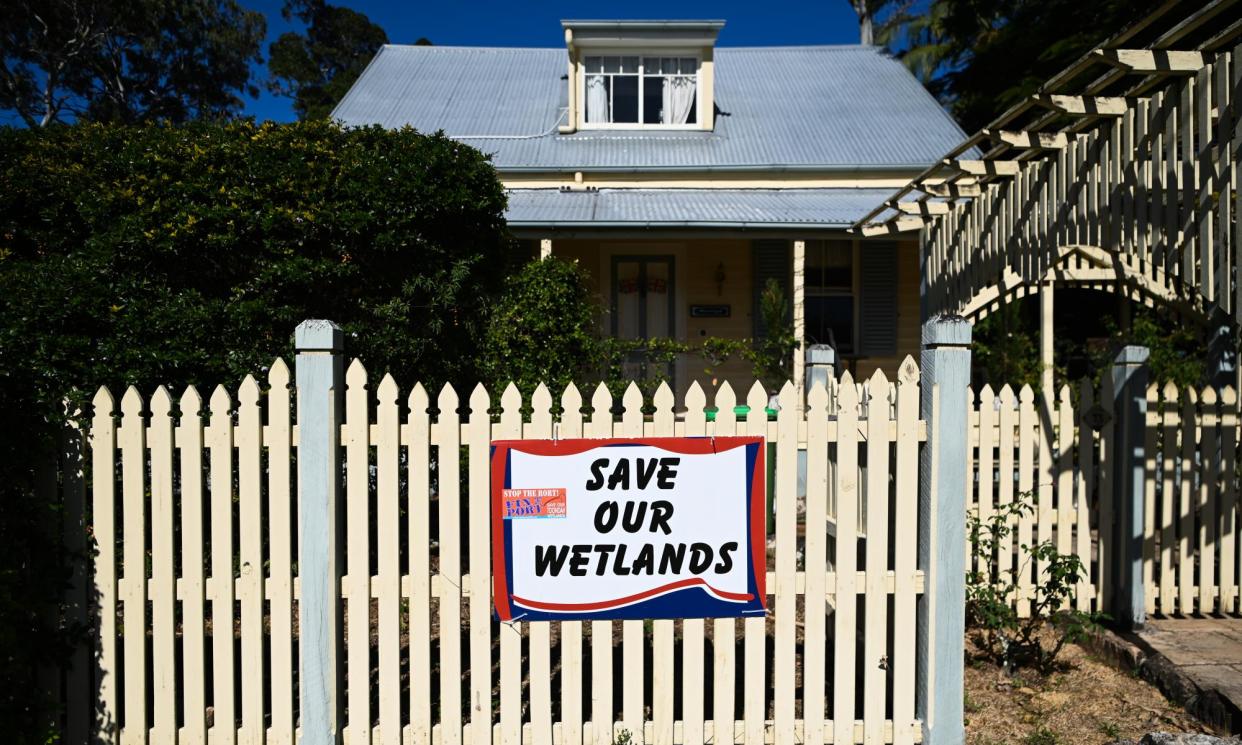Tanya Plibersek plans to reject a $1.3bn development at Moreton Bay. Why was it so controversial?

The environment and water minister, Tanya Plibersek, has indicated she plans to reject a proposal for a $1.3bn residential, shopping and marina development at Moreton Bay in Queensland.
Walker Corporation’s Toondah harbour project proposed to develop an area of internationally significant wetland that is habitat for migratory birds including the critically endangered eastern curlew.
Related: ‘A lot of question marks’: $70m renewable-energy microgrid project divides Daintree
Plibersek’s announcement looks set to end an almost decade-long battle by conservationists and community groups to protect the site, with longtime campaigners the Australian Conservation Foundation hailing it as a “landmark decision for nature and people”.
What is the development?
The property developer Walker Corporation proposed developing an area of the Moreton Bay wetland, south-east of Brisbane, into a residential and commercial complex with more than 3,000 luxury apartments.
The development would transform the area with shops, high-rise buildings and a 200-berth marina.
From the beginning the project attracted fierce opposition from environment groups and residents concerned about its impact on the wetland.
Moreton Bay is listed under the Ramsar convention, an international treaty set up to halt the global loss of wetlands and protect the ecological character of sites recognised as having international importance.
Walker Corporation’s proposal would develop on an area of the mudflats at Moreton Bay and carve out more than 50 hectares of the Ramsar site.
Why are the wetlands significant?
The wetland is important habitat for migratory species, such as the critically endangered eastern curlew, which feeds and recuperates at Moreton Bay after its annual migration from the northern hemisphere.
The site is a stopover for three other migratory birds – the great knot, the lesser sand plover and the bar-tailed godwit.
The area is not just a haven for migratory birds. Moreton Bay is habitat for humpback whales, dolphins and six of the world’s seven species of marine turtles. The site is one of the most important shorebird habitats in Australia and its sea grasses make it significant habitat for dugongs in Queensland with herds of more than 100 animals recorded.
“The planet is interconnected and this is a particularly important part of it,” said Kelly O’Shanassy, the Australian Conservation Foundation’s chief executive.
“It’s an important part of the world because of the wildlife that live there permanently or visit there.”
Why was this development so controversial?
The fuse for the most recent debate about this site was lit in 2013, when the Queensland government declared the area a priority site for development.
Because of its potential impact on a Ramsar site and threatened species, Walker Corporation’s proposal required assessment under Australia’s national environmental laws.
Had the former federal Coalition government accepted the initial advice from the federal environment department, the project never would have made it this far.
In 2018, the ABC revealed documents showed the former environment minister Josh Frydenberg had rejected advice from the federal environment department in 2016 that the project was “clearly unacceptable” because of the impact it would have on the wetland. Instead, the former minister sent the project to the next stage of the assessment process. Walker Corporation made a $225,ooo donation to the Liberal party in 2016 but Frydenberg said at the time his decision had nothing to do with donations.
Documents obtained subsequently by Guardian Australia revealed Frydenberg had proposed delisting an area of the wetland after he was lobbied by the developer. The decision to proceed to the next stage of the environmental assessment was also contrary to advice from the attorney general’s department, which warned it could put Australia in breach of its international obligations.
Walker Corporation later modified its proposal to try to make improvements and better integrate the development with the wetland.
Samantha Vine, the head of conservation and science at BirdLife Australia, said if the project was approved she feared it would have set a precedent for development within Ramsar sites not only within Australia but also internationally.
“It would have sent a troubling signal that these areas are open for business,” she said.
Vine said Plibersek’s proposed decision “vindicates” the environment department’s original advice to Frydenberg.
What has the reaction been to Plibersek’s proposed decision?
Environment and community groups have called the announcement a win for the environment and people power.
“This draft decision is a testament to people power. More than 24,500 people have directly contacted Minister Plibersek, urging her to reject this proposal,” O’Shanassy said.
“Thousands have taken to the streets calling on the Albanese government to save Toondah.
“The truth is a proposal for a massive real estate project on a Ramsar wetland should have been rejected when the department recommended that to then Minister Frydenberg in 2015.”
Conservationists said the Toondah harbour controversy also provided a “very clear” argument for strong new national environmental laws, including strict national environmental standards and an independent Environment Protection Authority that enabled a “fast no” to proposals with unacceptable environmental impacts. The Albanese government is consulting environment and business groups on new laws that are expected to be introduced to parliament this year.


